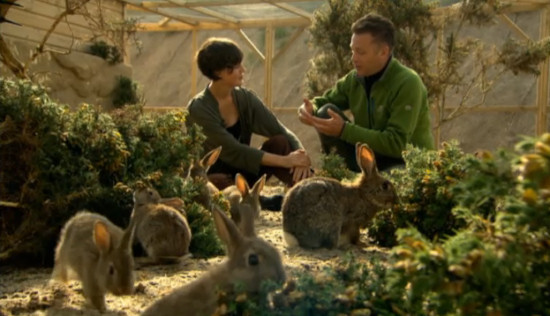The Burrowers: Animals Underground Part 3 (Rabbits)
The final episode of Animals Underground, is set above ground – with the youngsters growing up and learning to survive outside the warren. To recap, the original adult population has grown from ten to fifty odd, with the adult females on their second (a few none agouti’s in this batch!) and third litters.

Someone has been planting new gorse bushes between takes!
Population Explosion
We are told the winter population of wild rabbits in the UK is about 45 Million, in summer when they are breeding the numbers are even higher. Apparently rabbits within the warren time litters together so that the sheer number of young rabbits emerging means some survive, despite this just one in ten rabbits make it to one year old.
After posing the question “How do rabbits synchronise these waves of young?” we are told it’s down to the top buck (Thumper). As Hazel (top female) gives birth he stays close by and seconds after the babies are born Thumper starts working on the next litter. He repeated the same behaviour, mating with all the other females immediately giving birth. Peckham cites this as the explanation for how the litters are able to arrive at the same time. Which doesn’t seem like an answer to me. It will certainly insure that each female has a litter 28 days (roughly) after the last, but it doesn’t explain how the females synchronise in the first place.
In this case, the obvious answer is rabbits are induced ovulators, so they can get pregnant as a soon as they meet a male. Pop eight female rabbits in a limited area with a couple of boys and it’s a good bet that 28 days later most of them will have a litter, the males don’t wait around. But how does it work for established populations? Do the first litters of the season arrive at the same time?
3D Warren Mapping
Back to the concrete warren we saw excavated last week, and they use lasers to map it in 3D, then pass the data to scientists from Exeter, lead by Dr Dave Hodgson for analysis. This showed the distances between chambers, and between chambers and entrances were very even, though they didn’t say what it was – it would have been nice to know a rabbit idea of the ideal tunnel length.
The particular warren they excavated was around thirty years old, and had grown from a single scrape (nesting tunnel) to a home for fifty rabbits. The believe it developed in three stages, an initial section with large chambers, several entrances and a very interconnected network of burrows. Then some larger warrens with more connections, which they likened to ‘urban sprawl’. Finally there was another set of tunnels leading away from the central hub. This expansion is seasonal, with the summer breeding boom the females dig out new nesting chambers & tunnels.
The Start of a Warren
This leads on to the question: “How do warrens start in the first place?” Females get their pick of nesting chambers based on their position in the hierarchy. Hazel (top female) got the prime spot, where as rabbits like Beatrix ended up with a nesting spot in the middle of a ‘highway’. For other sub-ordinate rabbits there is another option – moving out. Acorn, the lowest in the pecking order, has apparently been excluded from the warren by the other females. This means digging her own breeding chamber (called a ‘stop’). We see Acorn digging in the sand above ground, but no information is given on whether she raises a litter or not. The nesting chambers dug by excluded female, could be who whole new warrens begin. At the excavated warren, they unearthered a smaller secondary warren, near the main warren – possibly started by a subordinate female, like Acorn.
What next for the burrowers…
That’s it for the series, so what’s next for the stars? The badgers abandoned the man-made set and built their own, they’ll be released into the wild a secret location, apart from one which failed a TB test. The water voles will be released in The Black Isle, Scotland as part of repopulation efforts.
And the rabbits will go back to the breeder ‘and get lovely homes’ with a few staying on at the warren. Quite how the breeder intends to find ‘lovely’ homes for forty-odd teenage agouti-coloured rabbits which have had no socialisation with people I’ve no idea, but if anyone finds out the secret I’m sure there are many rescue centres that would love to hear it.
So, what have we learnt?
Rabbits breed like rabbits. Pop ten unneutered rabbits in an enclosure and within a few months the population will be a lot higher. What haven’t we learnt? Much at all about feeding habits, the physical task of excavating the warren, communication, courtship… anything non breeding related really. And unlike water voles and badgers, humans have been breeding and observing domestic rabbits for hundreds of years. I don’t think this discovered anything new, or if it did it wasn’t shared with the viewing public.
Learning More About Rabbit Behaviour
 Has watching The Burrowers left you with the urge to learn more about rabbit behaviour? I’ve got just the book for you! Understanding Your Rabbit’s Habits by me Tamsin Stone.
Has watching The Burrowers left you with the urge to learn more about rabbit behaviour? I’ve got just the book for you! Understanding Your Rabbit’s Habits by me Tamsin Stone.
Leave a comment here and I’ll give one lucky reader a copy for free! If you don’t want to wait, you can buy a copy here.
Tags: Behaviour, wild-rabbit


I found your synopsis interesting, since I don’t know too much about rabbits in the wild. Please enter me in the drawing
I enjoyed reading these articles as I managed to miss the entire series! I’d love to win the book, one of my rabbits is acting very oddly and I’d love to know why.
Thanks for the summaries of The Burrowers. I watched all 3 programmes and enjoyed them – who couldn’t, with regular shots of adorable baby bunnies hopping, washing and snuggling! I do agree with you about the lack of new or scientifically relevant information though, I think for people with a genuine interest in learning more about the behaviour of wild rabbits the series raised more questions than it answered. Having said that, I think it lost all validity the moment they decided to use domestic rabbits, their reason seeming to be that the wild rabbits were ‘too wild’! The only thing I really learned was one of the things you mentioned in a previous post about the surface of grass being spiky and rough when viewed with a high-powered microscope. I really hope all the rabbits find good homes but I can’t help feel it’s inevitable that the majority will end up in inadequate homes or worse.
The answer to any kind of problem with rabbits seems to be make some more, rabbits that is, whereas Badgers if they have fleas air their bedding and Water Voles store food for coming gnerations. And yet domsticated rabbits express a number of different and interesting behaviors once pure survival instinct is more or less removed from the picture.